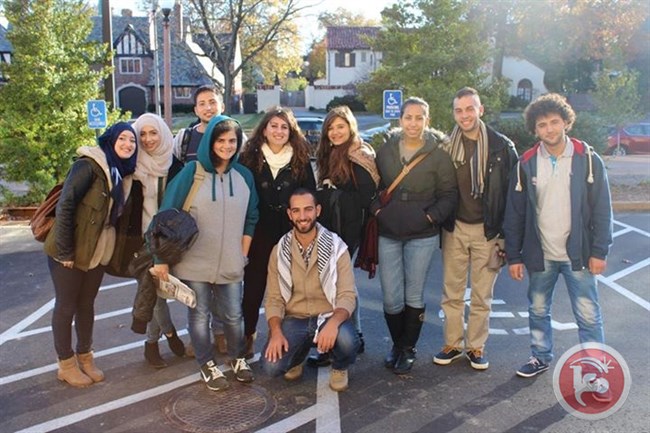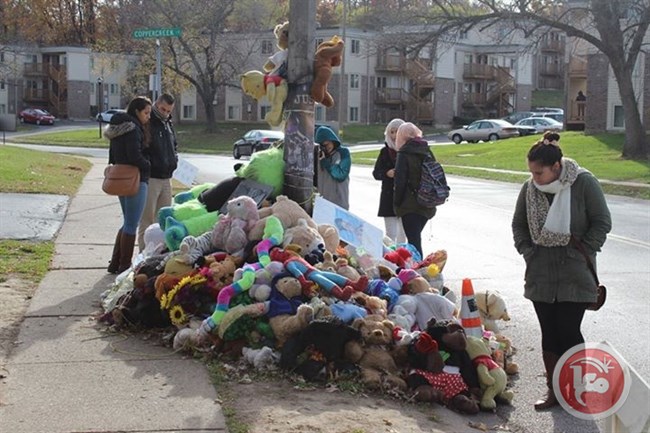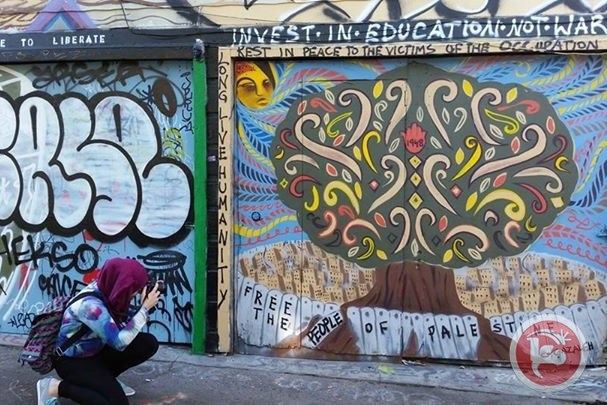Originally published on Ma’an News Agency on November 27, 2014.
BETHLEHEM (Ma’an) — 10 Palestinian students returned to the West Bank this week from a tour of more than 40 colleges across the United States where they spoke about the challenges facing Palestinians in their quests to achieve their right to an education.
The two-week tour, held from Nov. 10-20 under the banner “Building Unity, Wrecking Walls” as part of the Right to Education campaign at Birzeit University, was one of the first of its kind in recent memory. It was all the more striking for its insistence on discussing both Israeli obstacles against the Palestinian right to education as well as the challenges faced by youths of color in the United States.
Coming amid mass protests across the United States against police brutality in the wake of the killing of Mike Brown, a black youth from the state of Missouri who was unarmed and posed little threat to police when they shot him, the tour emphasized the need not only to share Palestinians’ experiences with Americans but also to “exchange information between Palestinians and US social movements fighting related issues of racism, colonialism, and attacks on education.”
Kristian Davis Bailey, a Stanford alumni and the US coordinator of the tour, told Ma’an that the tour “was designed to demonstrate that people and movements in the US also need the support of Palestinians, and for students from both locations to begin thinking about what ongoing relationships and joint struggle across borders might look like.”
He quoted one of the students on the tour, Mahmoud Doughlas, as telling him: “We tried to connect the dots between the struggles between the African American society and the Palestinians and we found this major solid ground that we share together — it’s that we are not allowed to narrate our own history.”
Indeed, for many of the Palestinian students the tour revealed a side of the US and its history that they scarcely knew existed. Bailey pointed out that the silencing of the voices in the United States shared many parallels with the struggles faced by Palestinian voices in reaching the global community.”
Israel and its hasbara machine have worked very hard to define the narrative of Palestinians and to obscure the injustices of the occupation,” he told Ma’an.
“This tour allowed Palestinians to shatter those walls and present their own unfiltered narratives to American audiences. Once people hear what’s actually happening, it becomes clear that pressure against these violations through BDS is the least we can do. Understanding the parallels and connections between Palestinians and peoples’ struggles in the US provides some inspiration for joint struggle for us to undertake together.”
The students’ tour across the United States, which covered five regions, began at a vigil in the St. Louis suburb of Ferguson for Mike Brown, where the 10 Palestinian students gathered to pay their respects and meet with local activists working against police brutality and the mass incarceration of black youths.
Deema al-Saafin, a senior at Birzeit University who took part in the tour, said that her experience had shown her that the obstacles faced by Ferguson activists were surprisingly similar to those they experienced back home.
“The Palestinian struggle is not a unique one and is part of the broader imperialist-colonialist struggle that many people worldwide are victims of. Thus Palestinians cannot resist alone, and local resistance should be paired with international resistance,” she told Ma’an after returning to the West Bank.



Highlighting US ‘complicity’ in Israeli occupation
Organizers said that the tour was highly successful across the United States, with crowds of more than 100 students packing halls to hear Palestinian students speak at some universities.
For the Palestinian speakers, the tour gave an opportunity to share the struggles faced by students with the world and reach a broad public in a country notorious for its pro-Israel political stance.
Al-Saafin told Ma’an that she was excited to have had the “opportunity to share the Palestinian narrative with audiences in the US and to witness first hand the success of the Boycott, Divestment, and Sanctions movement on US campuses.”
“A major aim was to highlight the complicity of US campuses in the occupation of Palestine by their investment in corporations that perpetuate the occupation of Palestine and thus cause education to be inaccessible to Palestinians,” she added.
She stressed that for herself and for other Palestinian students on the tour, the experience was an opportunity not only to share her experiences but also to encourage students to push their school administrations to boycott companies that profit from the occupation.
“Sharing real life stories of life as a Palestinian living under military occupation gave raw insight into what university tuition money helps perpetuate,” she told Ma’an.
The BDS movement has in recent years taken the United States by storm, and universities in particularly have witnessed numerous campaigns by pro-Palestinian students. Just last week, the student government at the University of California – Los Angeles passed a bill calling for divestment, urging the administration of the school of more than 40,000 to end economic ties with companies benefiting from the Israeli occupation.
For al-Saafin, victories at schools like UCLA — often in the face of intense pressure by Zionist lobbies and student groups — are reminders of the struggles she and others like her face in Palestine to receive an education under occupation.
“As a Palestinian, my right to education is targeted by the occupation in order to make it inaccessible, because an educated person is a person aware of their rights and duties to resist,” she told Ma’an.
Noting that 38 students at Birzeit University, where she studies, are currently being held in Israeli prisons, she stressed that Israeli targeting of Palestinian students took many forms. This includes not only checkpoints and refusal to offer permits for travel, but also restrictions on academic material imported by the university, early close times for campus institutions due to fear of settler attacks on the roads, regular deportations of foreign professors, and the isolation of Palestinian students in Gaza, Jerusalem, inside Israel, and the West Bank through its “apartheid” system, she said.
And while the details of the restrictions may not always be exactly aligned, al-Saafin stressed that for US students listening to her on the tour, the commonalities and experiences were more often than not shared.
“We related Palestinian students’ experiences by comparing the racism inflicted on Palestinians by Israel to the racism inflicted by the USA on indigenous, migrant, and black struggles. We mentioned how we are continuously dehumanized just for being Palestinian, thus finding a common ground we could work with with other oppressed peoples,” she told Ma’an.
“As a Palestinian I came to the conclusion that the means of communication with other struggles is dire so we have a duty to reach out effectively to them as well. The tour provided the means for this, by building networks and contacts with many student activist groups,” she added.
“I learned so much about intersectionality and solidarity and how students can connect with each other to empower and support each other. As oppressed people, our education is directly affected, and so education fits in the larger picture of resistance.”
